It has been almost a year since Lionel Scaloni assembled the Argentines to play for the national team. Finally, the young manager was given the chance to develop the team as they faced Ecuador at Alberto José Armando. The game was not an international friendly but rather an official match – 2022 FIFA World Cup qualification (CONMEBOL).
With Lionel Messi’s early penalty, Argentina sealed their first win in 2020 as Ecuador could not level things up even having improved in the second half. This tactical analysis dissects the tactics of Scaloni and Gustavo Alvaro.
Lineups
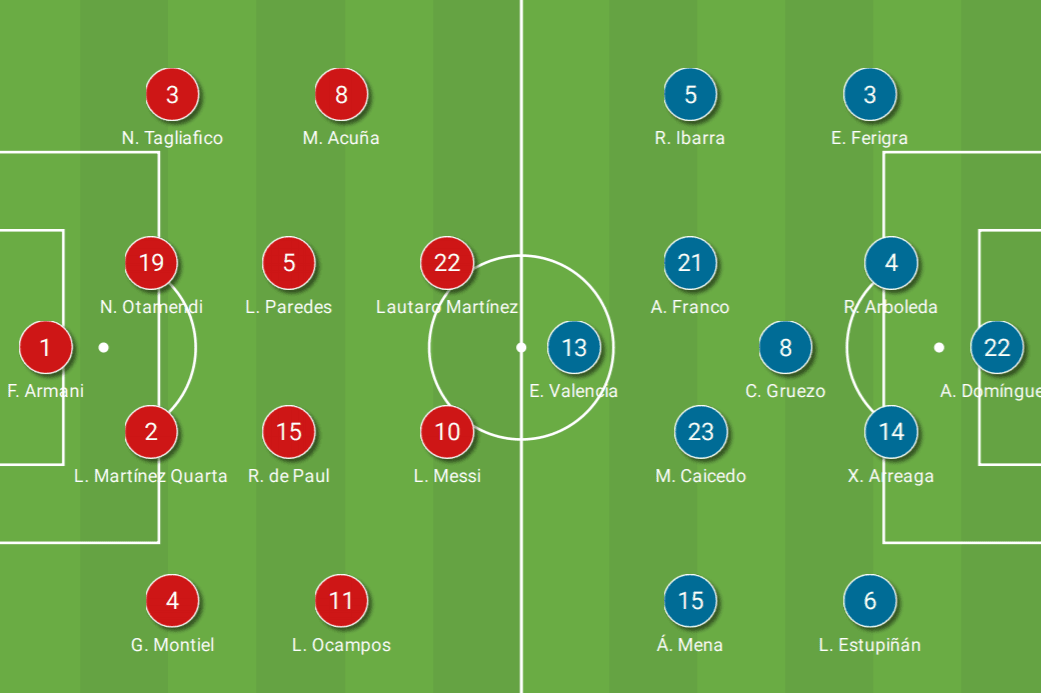
Manchester City star Sergio Agüero was not called up because of injury while Paris Saint-Germain’s Ángel Di María did not make it into the squad list. Needless to say, the team had some new faces in the lineup. Shirt number 11 was taken by Lucas Ocampos, and Lautaro Martínez played as the striker. Nicolás Otamendi’s partner was Lucas Martínez.
Some Ecuador players were playing in European leagues, and maybe the biggest star was Enner Valencia, who was a West Ham United player. Their midfielder Carlos Gruezo was playing at Augsburg, while full-backs were playing in La Liga and Serie A, respectively.
Argentina opened the shape to attack
With players possessing higher individual quality and playing for bigger teams, Scaloni wanted his team to play out from the back. The dynamic approach was interesting, as the team were constructing plays asymmetrically given Messi was a free player. The below tactics board is the brief version of Argentina’s setups.
Despite having Leandro Paredes as the pivot, another two midfielders – Marcos Acuña and Rodrigo De Paul – had different duties. De Paul was more like another pivot in front of the centre-backs, diagonally dropping into spaces as an additional option to progress plays. Acuña, who recently became a Sevilla player, was more like a left-winger who attacked the wide zones. However, it might have been a suboptimal decision since the zone was overcrowded when Nicolás Tagliafico also pushed higher to attack.
For players in the front line, Martínez could drop into spaces behind the midfield, while Messi could be everywhere when he was roaming. Another player to attack wide was Ocampos, who was supported by Gonzalo Montiel. Players on the right would rotate when Messi took one of their positions, as either Ocampos or Montiel moved correspondingly.
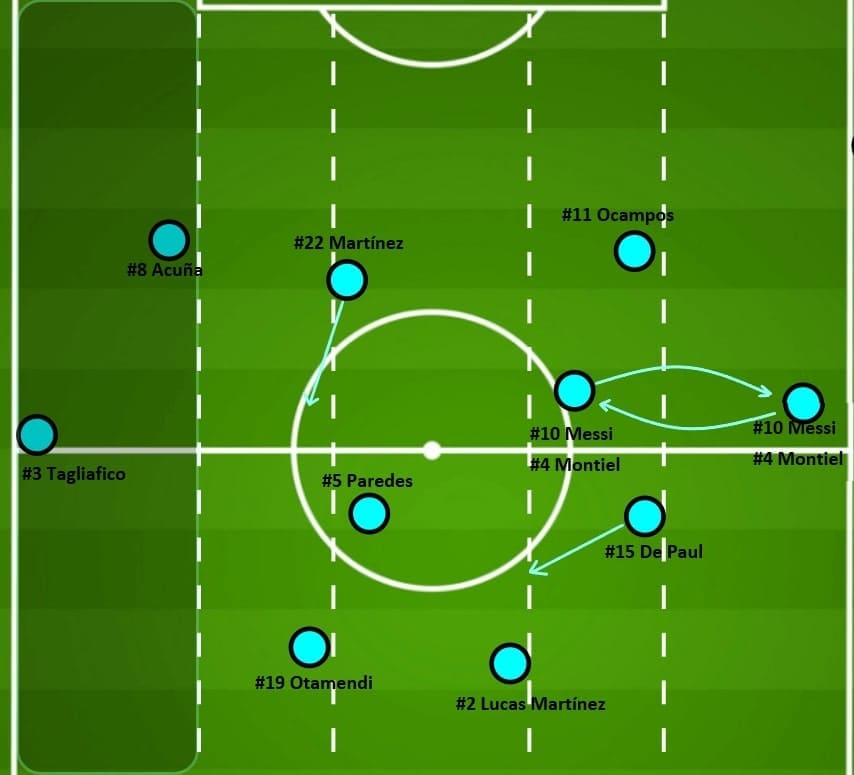
In this game, the Argentina side faced an opponent defending with a 4-1-4-1 shape. It was more of a zone-oriented approach and the engagement line was near the halfway line. Therefore, Scaloni’s side should be able to open the shape and control the tempo of the game. The second line of the defence usually stepped up when the ball was in the same vertical zone, but the communications between wingers and midfielders were vital.
In this example, Ecuador’s right midfielder Alan Franco stepped up to pressure Paredes, and Valencia should stay at the centre. This was why the team needed De Paul to drop in the build-up, as the Udinese midfielder always offers himself as the leeway to escape from the block.
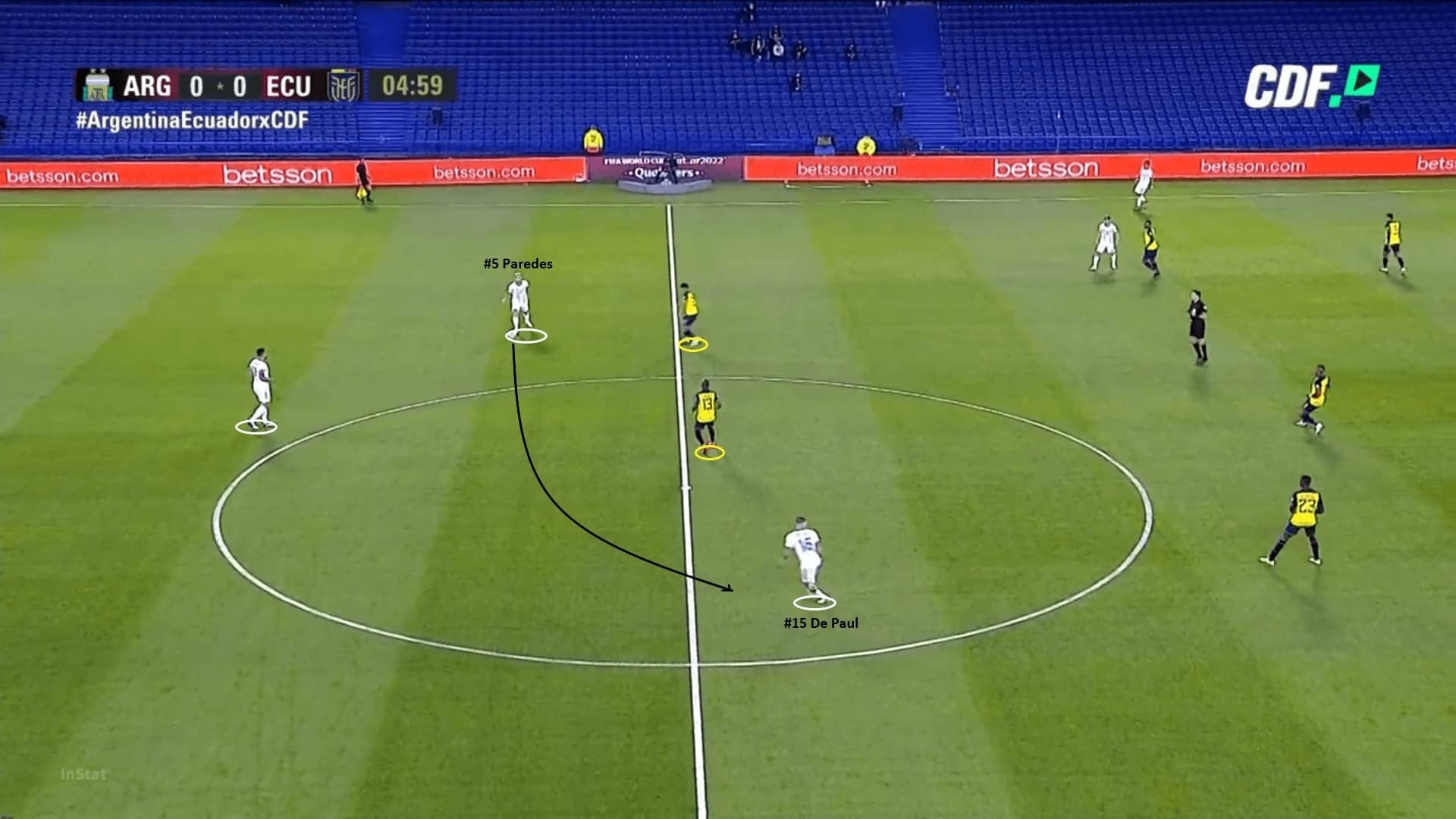
However, it seemed Ecuador also adapted to the dropping movements of De Paul as the game went on. On more occasions, the winger caught the midfielder early and Argentina nearly conceded an opportunity before the break.
The below image is an example of it. It was Ángel Mena to press instead of the midfielder in the same vertical zone. This tweak helped the defending team to press in a better angle, as De Paul would check Moisés Caicedo’s position in the above image. However, it was difficult for him to see Mena’s press, as the left-winger was at his blindside if De Paul entered the spaces diagonally.
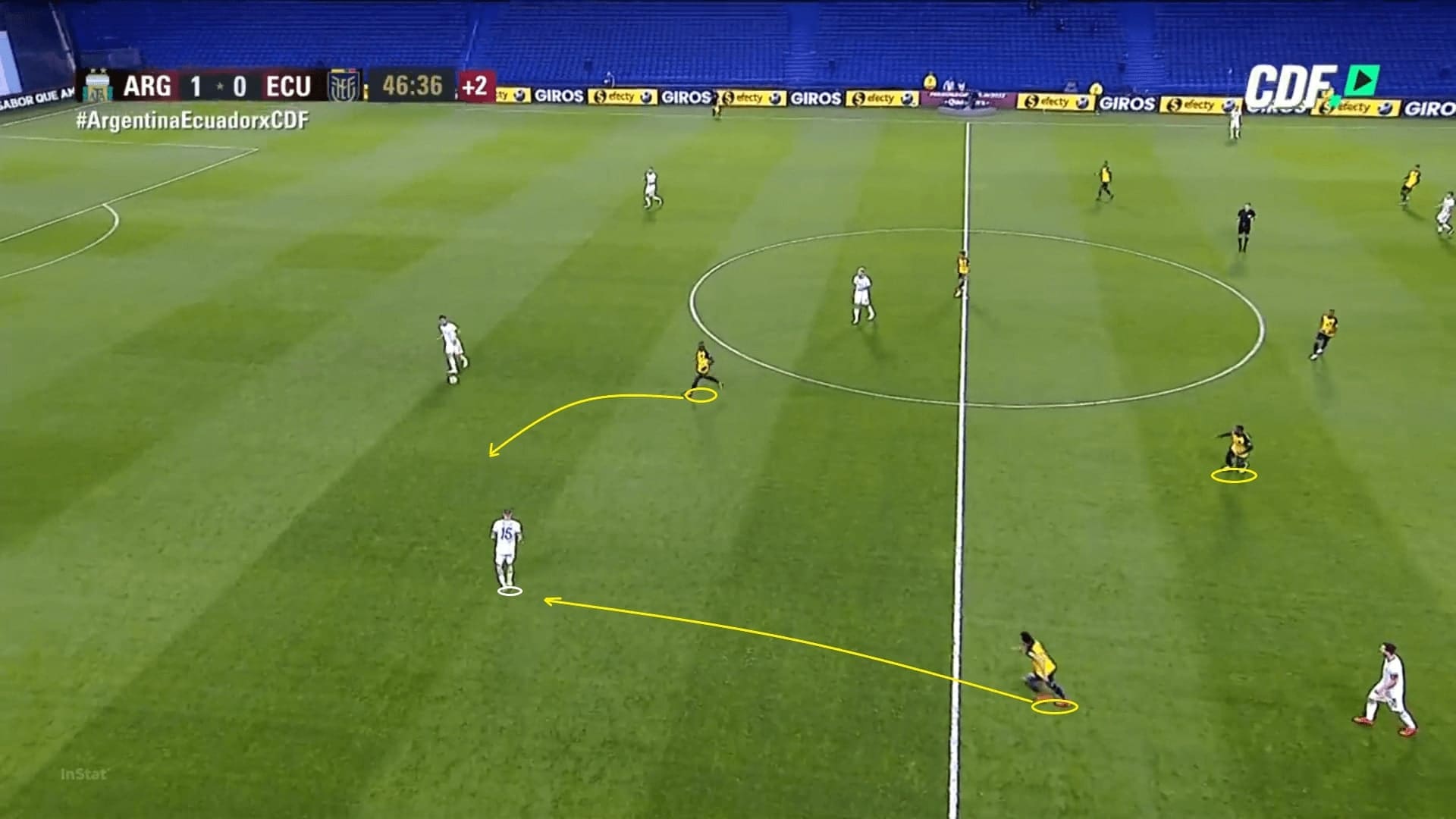
However, the approaches were not effective enough in this game. One of the reasons was the verticality involved in the build-up, but the receiver was usually without the help of the third man. The opposition was aggressive to move in front of the receivers to intercept the ball, or at least pressuring from the back, not letting him turn.
Another reason was the team shape – the players lacked proximities to connect with each other. Yes, the team occupied every vertical zone and made the pitch very big in the offensive phases. Yet, the front line was flattened, which means the players were not generating enough passing angles to play quick combinations. The flow of the passes was predictable for the defence.
Argentina attacked with numbers on the right flank more because Messi was here. On the weak side, Acuña lacked qualitative superiority to create dynamics in 1 v 1 situations. Also, the zone was congested as Tagliafico seldom choose an effective running path when attacking.
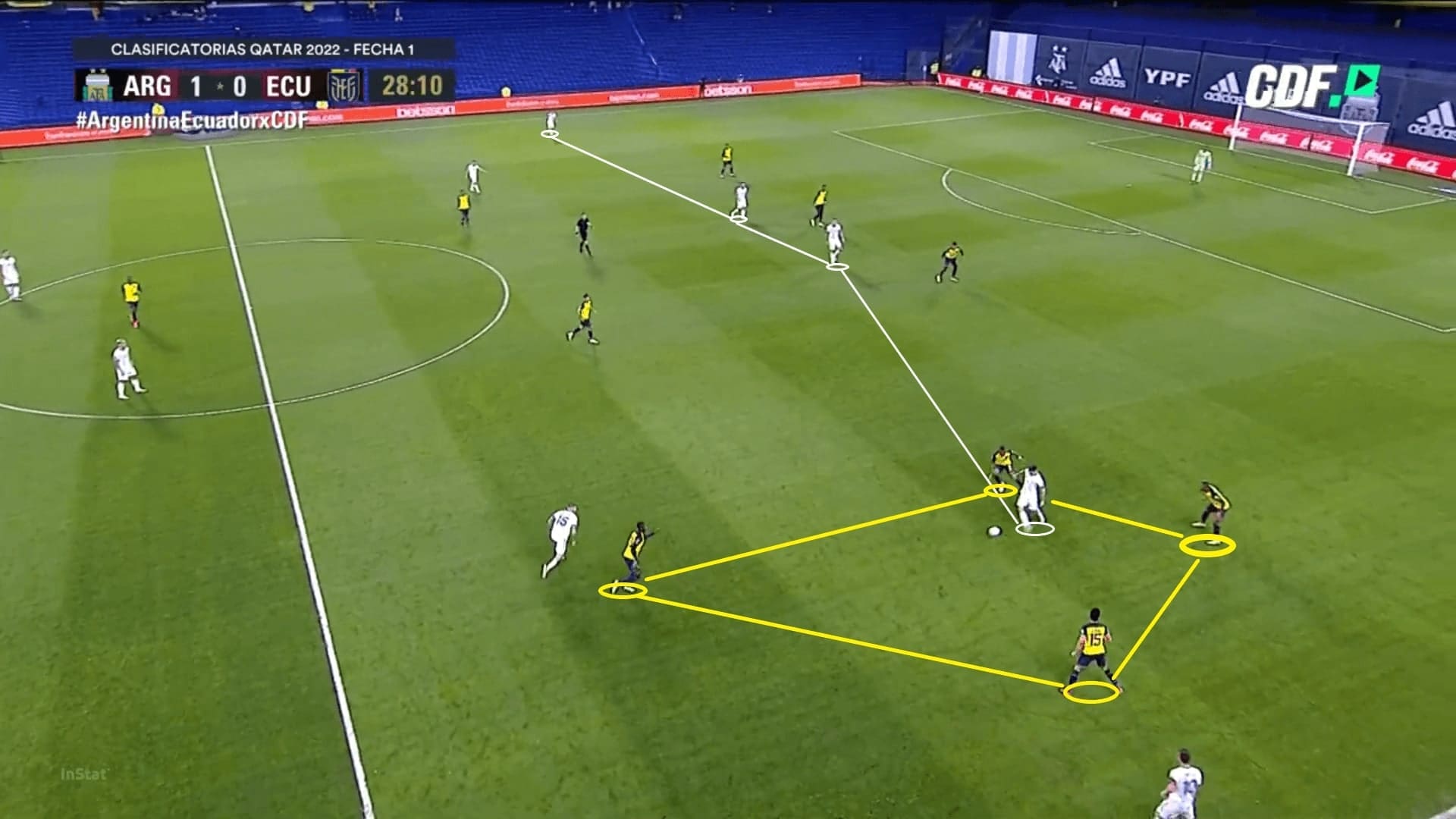
The above example shows the problem when the shape was flat. The receiver Montiel did not have good options even as a passing triangle was formed. Ecuador did well to close the wide spaces with high challenge intensity and created a 4 v 3 numerical superiority in this zone. More importantly, passing lanes to Messi were shut as well.
Even when Montiel tried a difficult one-two with De Paul, the opponent had already read it early and squeezed those spaces. It was a possession turnover. Despite having a solid build-up phase, Argentina’s structural issue hindered the team from creating many quality chances in the final third.
High block
Scaloni had an interesting problem – how to use Messi effectively. We all know Messi does not defend a lot at his club, and it was difficult for a team to survive without pressing. Given the limitations of Messi, Argentina more often set a high block to defend in a 4-3-3, but the Barcelona star should be praised for pressing more than usual in this game.
To accommodate the individuals, the defensive workload of the second line was increased. Firstly, the first line of Argentina must be flexible, as the other two players need to form the three-man line with Messi. For example, When Messi stayed at the striker position, the other two should operate as wingers temporarily. The most important thing was to keep this line narrow which avoided Ecuador’s first ball to enter this zone.
Since the opponent also stretched very wide in the build-up, the Argentina second line must respond by moving the wide midfielders. Acuña and De Paul were the players to press the centre-backs, instead of the wingers. In this image, Argentina kept the first line narrow while Acuña was approaching the centre-back.
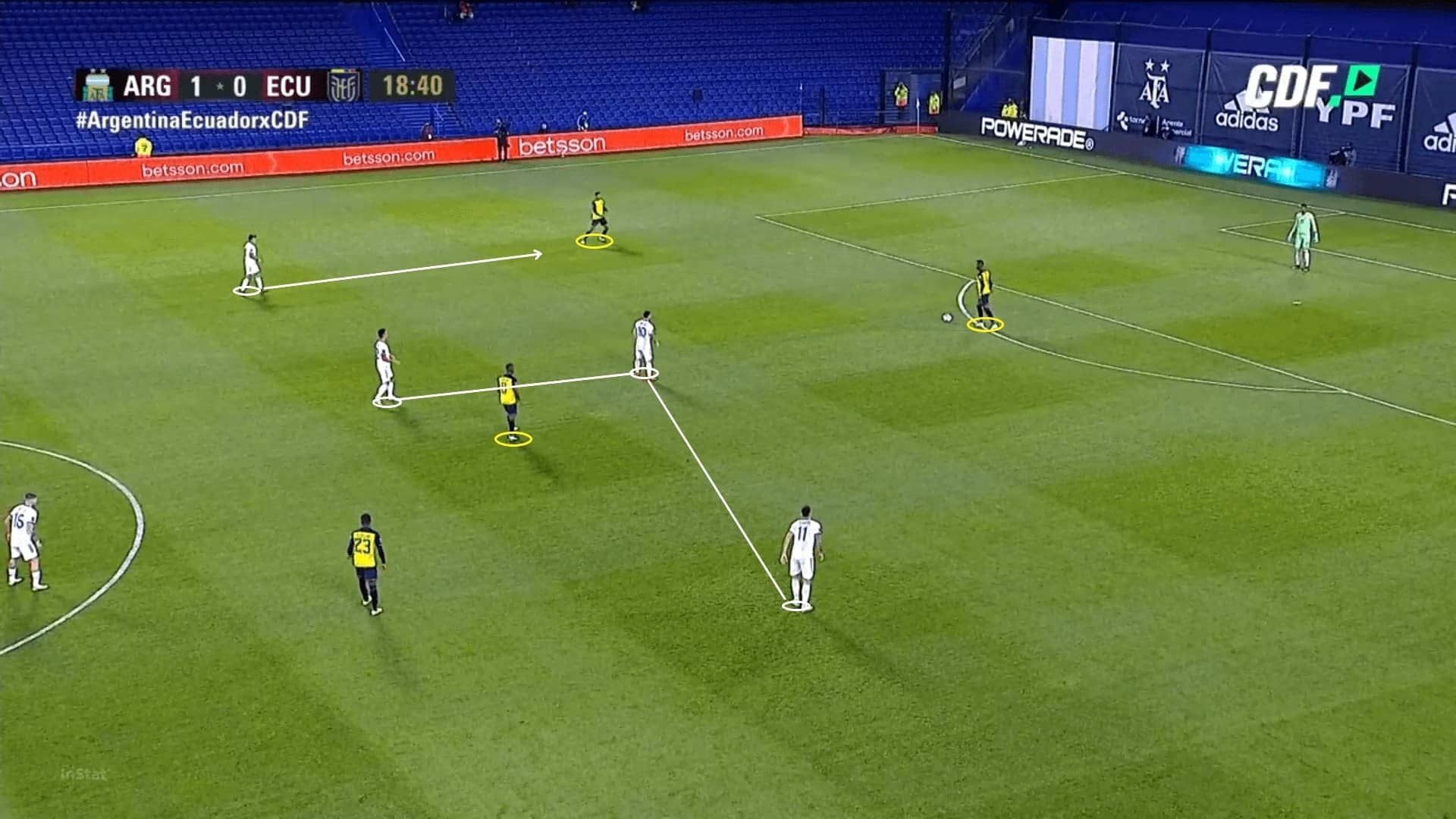
Ecuador were trying not to fall into these traps. They played a lot of long balls to try to build-up around the Argentina block. This means they were not exactly going into spaces of the block, but outside of it, where more spaces were available for the players.
The vertical compactness of Argentina’s lines might need to improve, as the weakness of the 4-3-3 block was exposed today – not enough horizontal coverage. Therefore, the opponents were able to access wide spaces to construct the attack. The below awkward shape was a result of the defensive approach as explained in the above analysis. When Acuña stepped up, Paredes must also adjust his positions to provide the defensive cover. Another player to join the press was Tagliafico, who should close the wide option as soon as possible. Ideally, the opponent could not escape in this zone.
However, better execution was needed. Acuña was late on the ball below, while Tagliafico was late to his target. The issue was the area that needed to be defended – it was too large. It seemed the players were not good enough to defend in huge spaces yet, maybe some adjustments were needed to improve on the pressing.
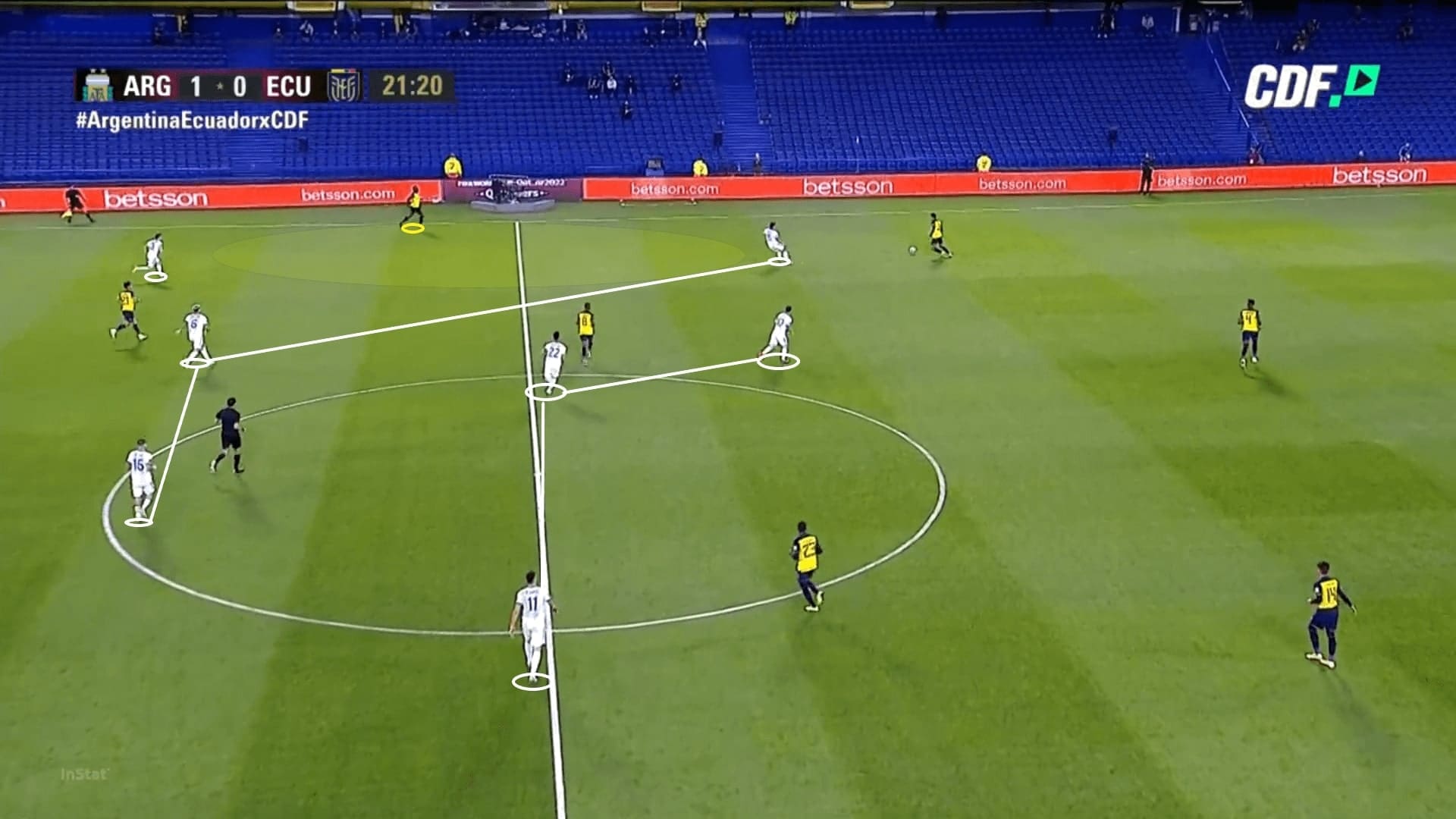
Alexander Domínguez, the Ecuador goalkeeper, was tasked to play a lot of long balls against Argentina. The target would be either Valencia or hitting the wide spaces. It was the main tactical approach of the team. The below example was a variation from a goal kick, as the ball was played by the centre-back instead.
The most important was the positioning of the wide players. Both of them were behind the Argentina five-man block below. If the long balls were successfully played, Ecuador could eliminate half of the outfield players, facing the backline directly. Nevertheless, they did not manage to play these passes accurate enough that day.
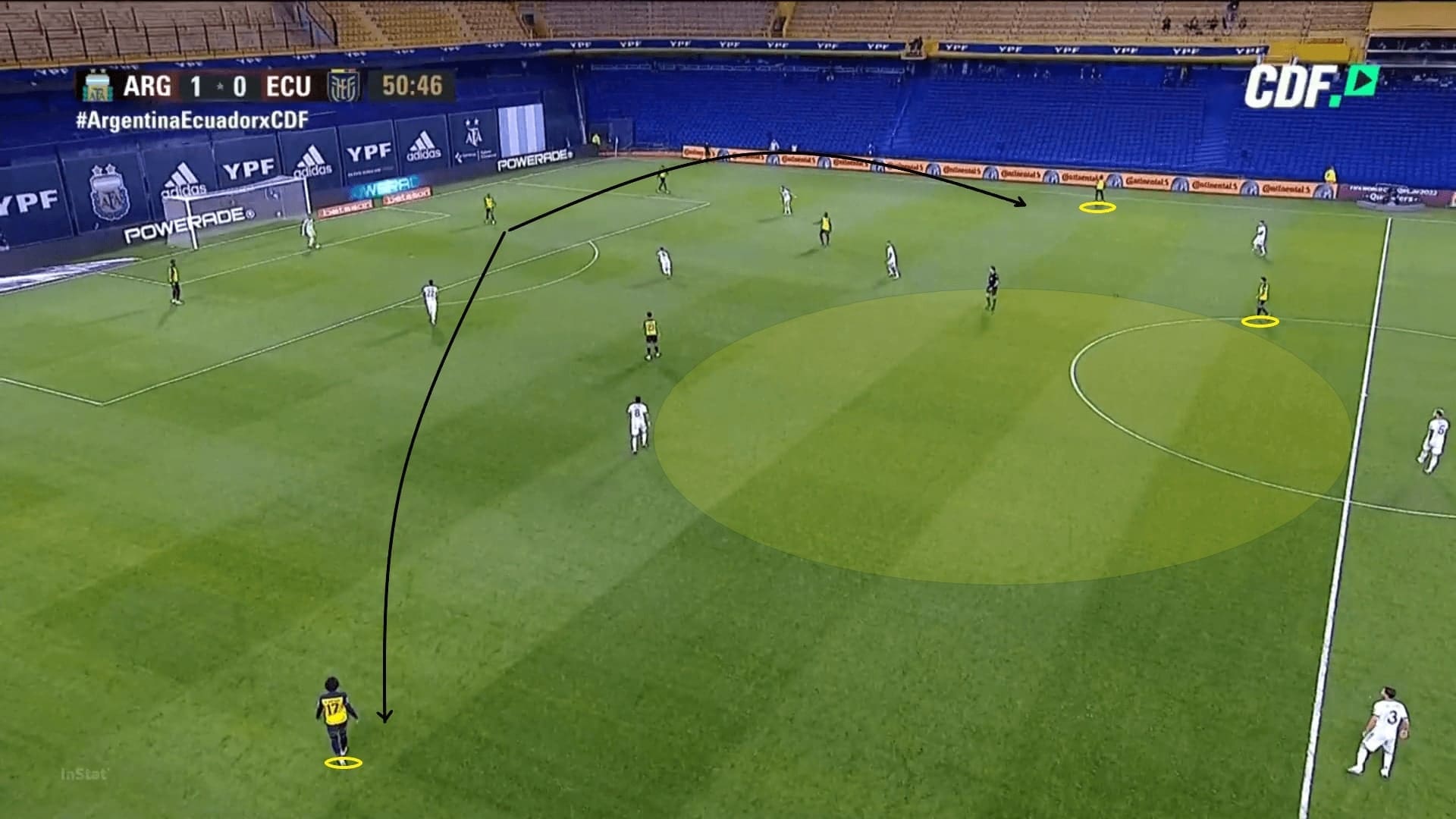
Adjustments and adaptations in the second half
Perhaps Alvaro was not satisfied with his team’s performance since tactics of Ecuador changed a lot in the second half. Defensively, they were much more aggressive, pushing the engagement line higher with more men to press the opposition backline.
Valencia needed to defend more from the first line. In the second half, he did a tremendous job by cutting the links between the centre-backs. If he was doing the job from the first line, Ecuador only needed to defend in either vertical half, which saved energy and was easier to defend.
Meanwhile, the second line should join the first line to press the wide passes early. With the high intensity to pressure the opponent, the Argentines did not have much time to think. More long balls were forced after the break as Ecuador regained a lot of possession at their backline given their stronger physical strength against the opponents.
In this example, the winger pressured Tagliafico while Valencia went for Otamendi. Paredes was also unavailable because of the shadowing work of the midfielder. It was a good sign for the team as the front players were defending together as a unit.
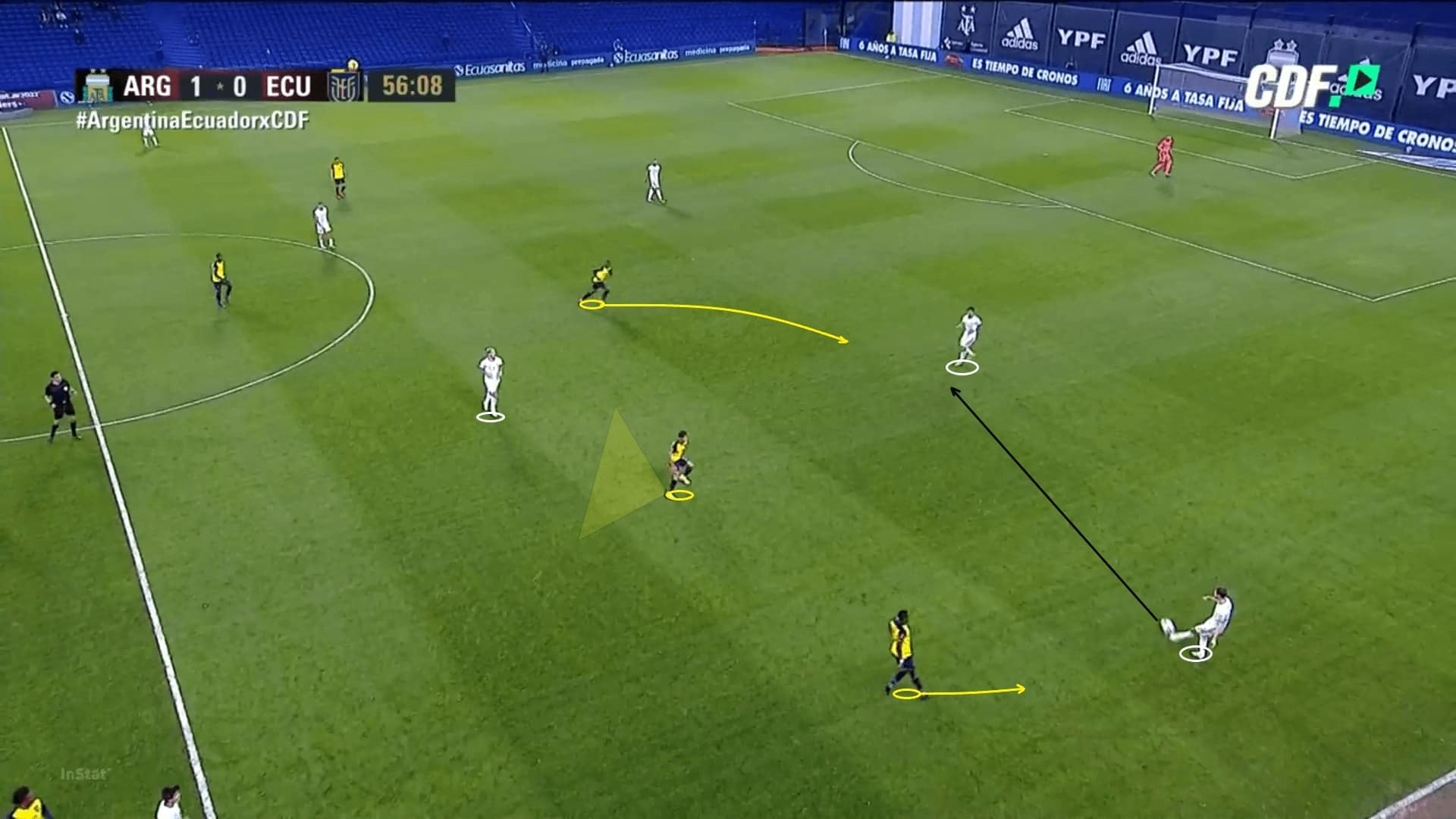
Argentina took almost half an hour to adapt to the adjusted pressing system of the opponent. Sometimes they needed wall passes to absorb pressure or circulate the ball, which could break the defence. The dropping movement of De Paul was not working as good as it was in the first half.
Here, even Valencia intended to keep the ball in the left vertical half of the pitch but Argentina players cleverly responded by using Paredes as a point to absorb pressure. He could either return the ball or transfer it to another centre-back, who was unmarked.
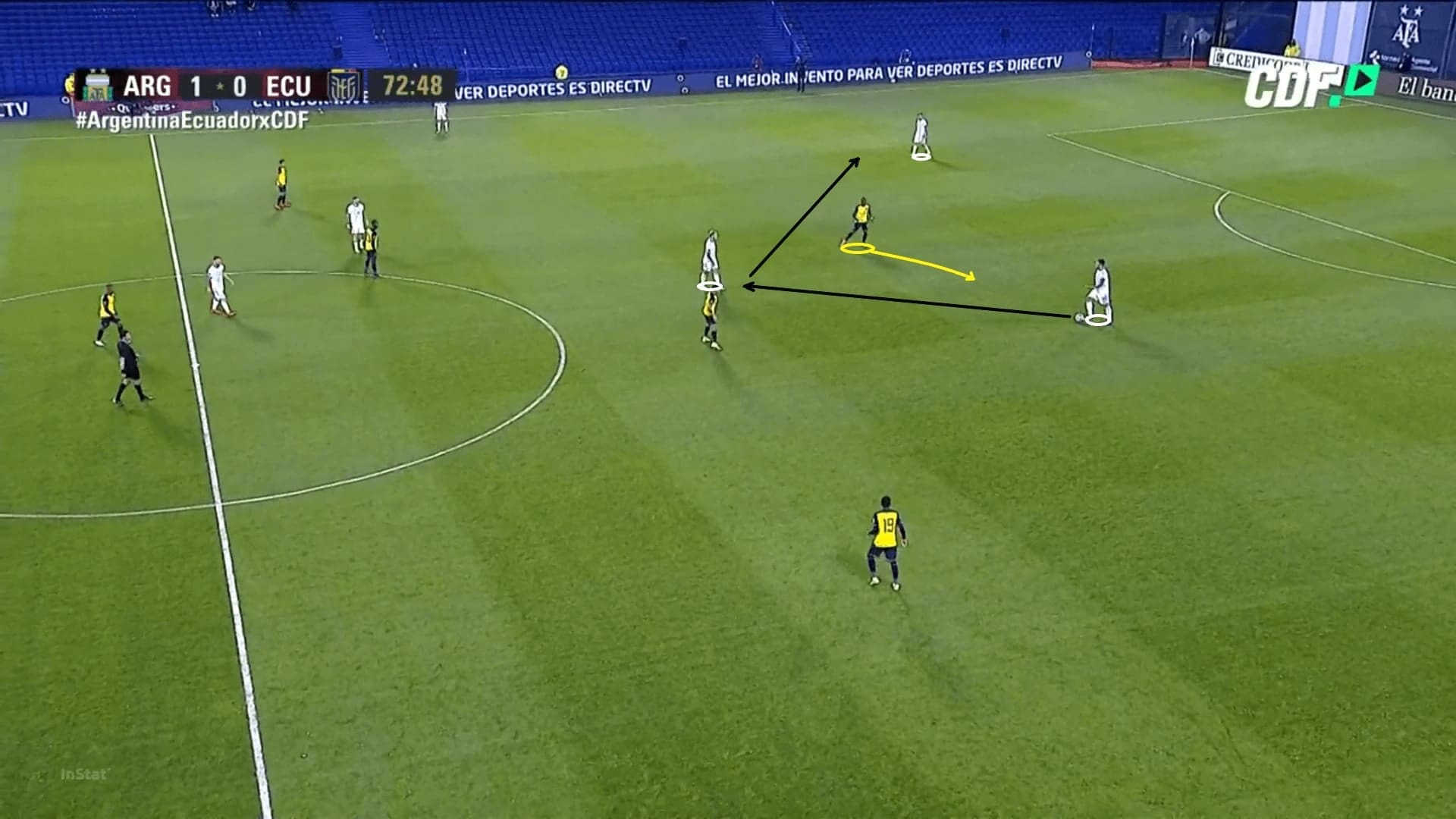
Below is an example of scenarios when Ecuador were forcing a long pass. They committed many players to overload this vertical half – at least six yellow shirts were in this crowded space. The defenders did not have to defend huge spaces as the long ball was forced into this zone, given the pressuring efforts of players in the first line.
The Argentina structure was loose since the team was unable to control the tempo and the players did not have the time to adjust their positions. Consequently, the receiver was trapped by four yellow shirts, which was a difficult situation to escape.
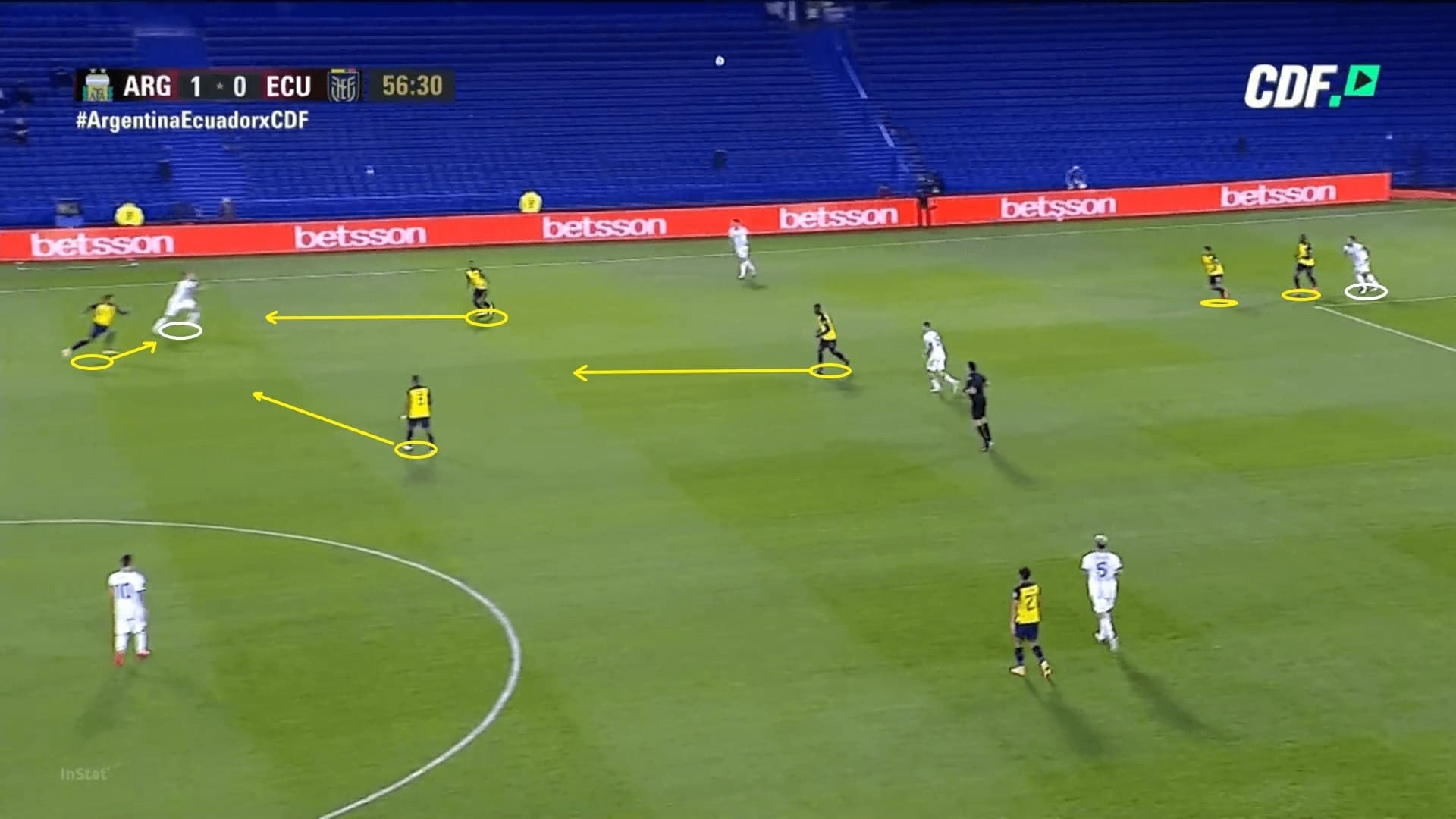
Offensively, Alvaro and his staff instructed the team to play a bit differently, though the concepts were the same. Ecuador were still attacking the flanks, but now they committed more numbers. The full-backs pushed into advanced positions earlier, and the team was specifically attacking spaces behind the full-backs.
Argentina tried to control wide spaces with full-backs pressing early but Ecuador capitalised on this tactic to exploit spaces behind them, especially Tagliafico. By inverting the right-winger and encouraging dropping movements, Tagliafico was always pulled out of position, leaving the wide zone without defenders. At those moments, the Ecuador right-back Ayrton Preciado must access those spaces with his runs. On most of the occasions, Otamendi was forced to cover those zones, or Acuña dropping as a false wing-back to create a back five. Ecuador gained more control of the game with this approach, but the deliveries could’ve been better.
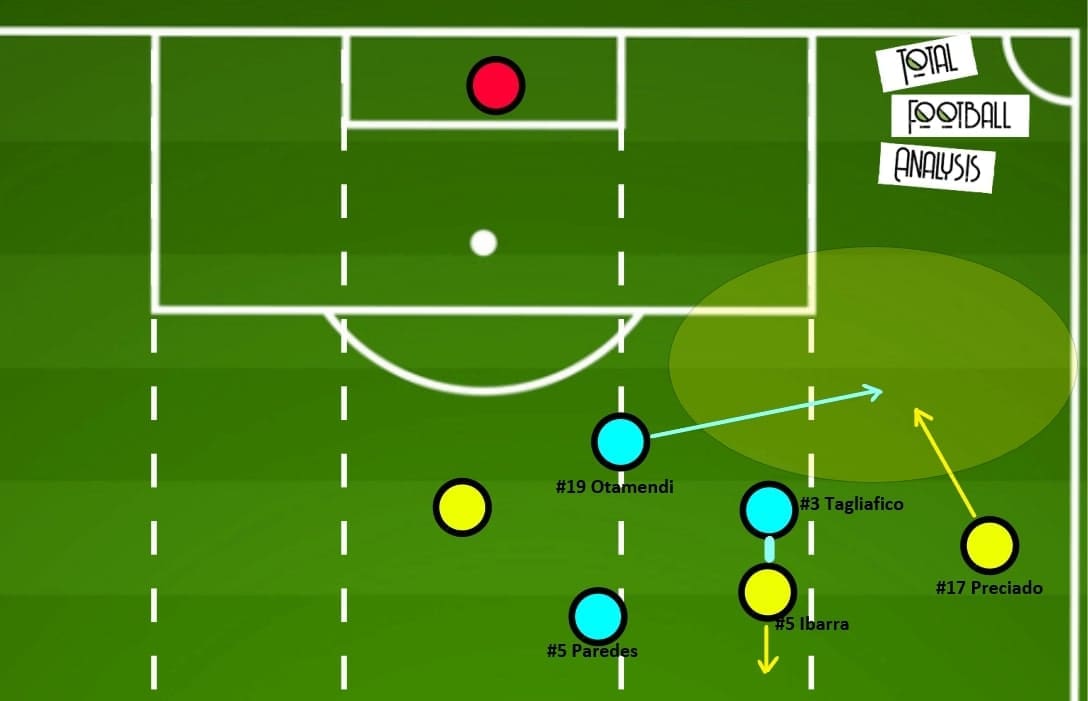
Below is another example of how Ecuador attacked the flanks. Because of the narrow wingers, a numerical overload was also created at the centre. This means Argentina were forced to place more players centrally at the expense of leaving wide zones free.
Since Ecuador were not too good at playing quick combinations or penetrating at the centre, they relied on diagonal balls to flanks to access the final third. Below is one of the routines where the midfielder with spaces should distribute the ball wide. Similar to the above cases, the pass was not good enough to convert into 1 v 1 situations, let alone opportunities inside the penalty box.
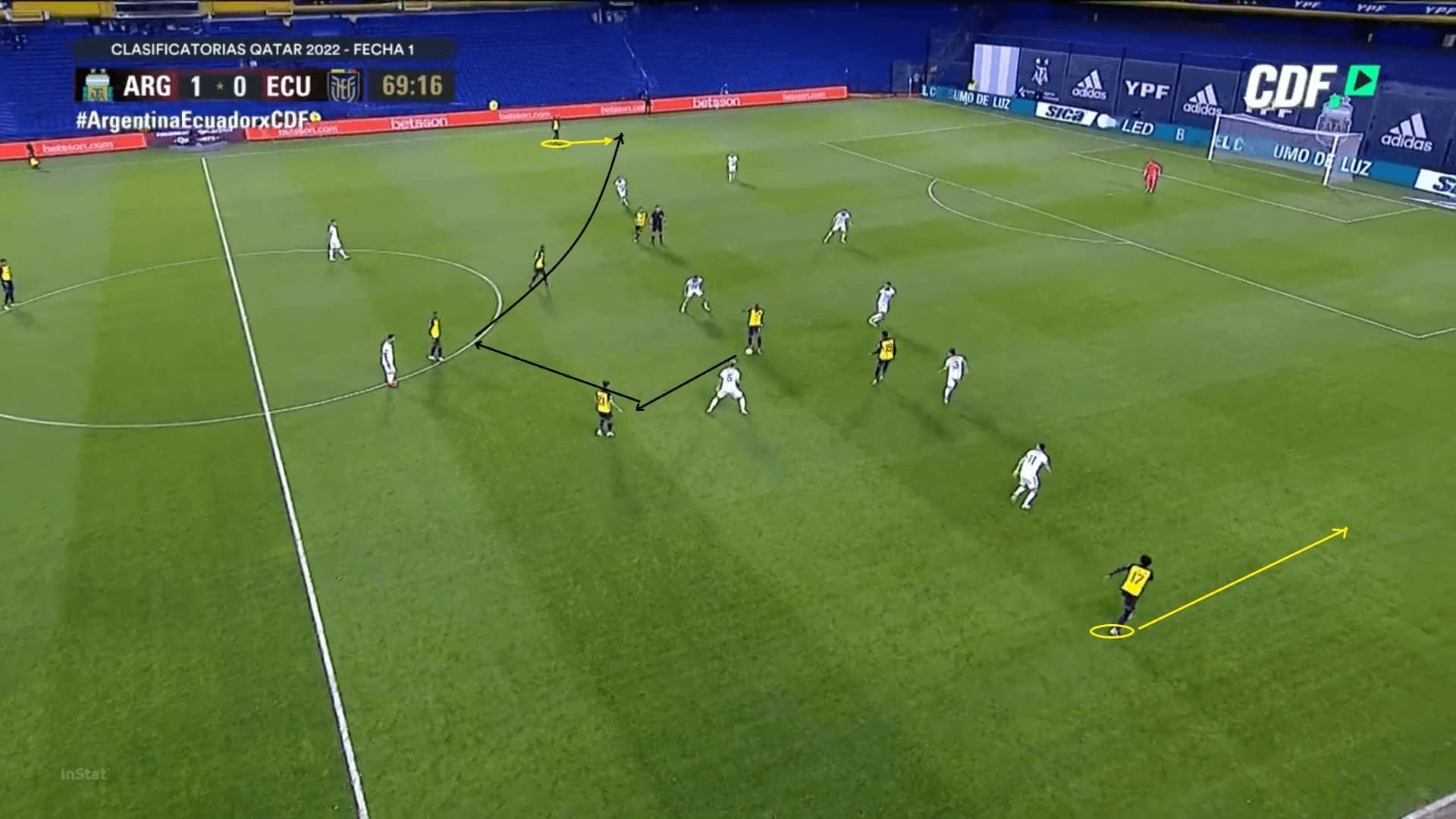
Final remarks
It was just the first game and some players were clearly not 100% fit enough to play. For example, Paredes’ performance level was below par as he could have controlled transitions better to help the team dictate plays. Ocampos had a decent chance after the break but did not grab it. Scaloni will probably demand more from his players.
Ecuador were not quite in the game in the first half but they were a lot better in the second half. The change of how they got access to open spaces was good, and they kept the intensity until the last minute of the game. Another part to be mentioned were their transition plays, as Alvaro’s men did well enough to hit spaces behind the midfield during possession turnovers. However, more quality in the final third was needed to create more dangerous chances.




Comments